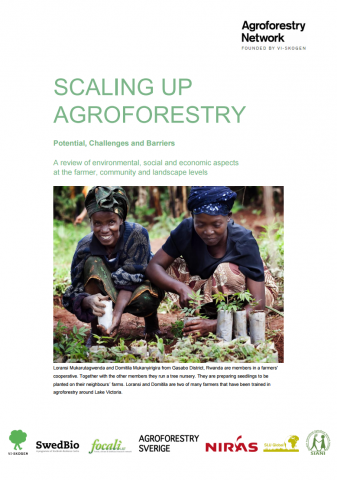SCALING UP AGROFORESTRY: Potential, Challenges and Barriers
Abstract
Ecosystem services from trees contribute to food security and sustainable development. Increasingly, organisations and institutions are recognising the value of ecosystem services from trees on farms and in agricultural landscapes for food security
and to sustain productivity. For smallholder farmers these services can be important for securing livelihood strategies, especially for farmers living in poverty, as trees provide
fodder, food, fuelwood, finance and soil fertility. Smallholder farmers with less than 5 ha of land, produce around half of the world’s food, but many of them are living in poverty and
suffer from food insecurity and malnutrition. Unsustainable land management and climate change is degrading the environments these farmers live in and depend on. As the remaining forests in the world are threatened by a growing demand for food, feed, fibre and fuel, these farmers will face additional challenges, especially in a changing climate.
Agroforestry supports farmers’ livelihoods while reducing pressure on forests. Agroforestry, i.e. to combine crops, trees and livestock, is a promising land management system that can improve farmers’ livelihoods while reducing pressure on forests. In this report, the commonly reported positive and negative effects of agroforestry have been compiled in a thorough review that shows that agroforestry can provide many tree-related
ecosystem services such as biodiversity and increased soil fertility, and can contribute to water management. Agroforestry also contributes to reduced erosion, a common environmental problem in tropical regions, and carbon sequestration thus reducing the net global emissions of greenhouse gases. Fuelwood from trees is essential for about 2.4 billion people by providing energy to cook food, and agroforestry has potential to support
large parts of the rural population with fuelwood. However, most of these positive effects are dependent on a proper management and use of suitable tree species for the purpose and context (‘the right tree for the right place’). If done correctly, agroforestry increases agricultural yields and improves the food and nutrition security of farmers living in poverty, while helping them adapt to more variable and extreme weather. Climate adaptation is
particularly important for female farmers as they often have less access to resources compared to their male counterparts. Female farmers produce a major part of the food in many regions but generally do not have the same possibilities as men do to improve their livelihoods. Agroforestry can be a suitable land management system to reduce gender inequalities related to natural resource access, while contributing to increased control of their benefits.
Agroforestry is not commonly promoted as a viable sustainable agricultural system. Most countries with a large portion of their population engaged in agriculture have not included agroforestry in policies, land management strategies, development plans, or
extension services. The paradigm is instead to separate agriculture for food production, while forestry if focused on timber production and for providing ecosystem services. This
paradigm has created numerous barriers preventing a scaling-up of agroforestry. In this report, the most important barriers are analysed and actions presented for how these can be removed. The analysis shows that farmers are facing challenges when practicing agroforestry as there are few value chains developed for agroforestry products and for connecting them to consumers and the market. The long return on investment in agroforestry is also problematic, as many farmers do not have access to capital, credit or secure tenure for their land. This is especially the case for female farmers. Other barriers are found in research and higher education institutions dealing with agriculture or forestry,
preventing agroforestry from being scaled-up efficiently.
This report concludes that if the current barriers are addressed, farmers can fully benefit from agroforestry practices. Promoting value chains for agroforestry products and services is an important action to take. It is also essential to strengthen the
agroforestry capacity of national extension services, combined with the use of new technologies such as drones and mobile phones. Stronger farmer groups or cooperatives can also provide extension services for their members and connect them to markets. Promoting participatory research and identifying drivers of change in different contexts can further serve the purpose of a scaling-up process. Exchange and cross-fertilisation
between local knowledge and agroforestry research can generate innovations to be disseminated widely, with potential to increase yields and support adaptation of agriculture to a changing climate while preserving the environment and mitigating greenhouse gas emissions.

